Note: this is the fourth installment in a series of articles. The first part was posted here: http://leadheadpencils.blogspot.com/2014/10/artfully-to-point.html.
The future of the Dollar Point Pencil Corporation looked bright at the beginning of 1921. The company had a great new pencil mechanism with fantastic styling, protected by both utility and design patents. The company’s factory was turning out 1,000 pencils per day by mid-year, with plans to double production and construct a larger factory to move into as soon as they company’s lease expired. The former West Coast agent for the Eversharp Pencil Company saw promise in the new pencil and negotiated exclusive rights to distribute it, and J.E. Roach & Co. hired an advertising firm in preparation for a big national advertising campaign.
And then, just as the Artpoint pencil was poised to take the country by storm . . .
nothing.
Somewhere along the way, the wheels came off the locomotive just as it was gathering an enormous head of steam, and the Dollar Point Pencil Corporation seemingly evaporated into thin air. How?
Maybe it was just that the timing was bad. The industrial boom of World War I went bust in 1920, and the United States suffered through a short but very steep Depression that lasted through the middle of 1921. Perhaps Dollar Point stretched itself too thin at a critical time, crippling itself with so much up-front debt that the company wasn’t able to pull itself out, even as the economy improved towards the end of 1921.
But there’s also that curious detail in which Jesse E. Roach established a second company which simultaneously claimed to "manufacture" the Artpoint and Dollarpoint pencils. It’s possible that J.E. Roach & Co. and Dollar Point were created for accounting or strategic reasons, one set up to do the actual manufacturing while the other handled marketing and distribution But another possibility is that there was infighting amongst the principals which eventually brought the company down. Jesse E. Roach appeared to have been the only common denominator between the two companies, and all the patents were assigned to him; Dollar Point was headed up by Amadee Taussig, who created the styling for the pencils. Perhaps Roach wasn’t satisfied with the progress his partners were making towards returning his investment, so he decided to take matters into his own hands, setting up J.E. Roach & Co. in order to hijack Dollar Point’s business – that might explain the sudden appearance of the elusive "Western Pencil Company" a couple years later.
But I have another theory, one which would make Occam proud in its simplicity: Dollar Point wrestled with an 800-pound gorilla and lost. In part one of this series, I commented on the obvious similarities between the Artpoint/Dollarpoint pencils and the Eagle Pointer:
To learn more, this full article is included in The Leadhead's Pencil Blog Volume 3, available at Amazon, Barnes & Noble and everywhere else you buy books, or you can order a copy signed by yours truly through the Legendary Lead Company HERE.





























